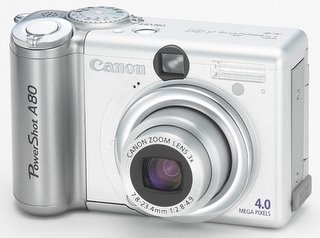Canon Powershot A80 Digital Camera

Cnet Reviews Canon Powershot A80 Digital Camera and says:

DC Recource Reviews Canon Powershot A80 Digital Camera and says:
The PowerShot A80 has a good bundle. Inside the box, you'll find:
- The 4.0 (effective) Mpixel Canon PowerShot A80 camera
- 32MB CompactFlash card
- Four AA alkaline batteries
- Wrist strap
- USB cable
- A/V cable
- CD-ROMs featuring Canon Digital Camera Solutions and ArcSoft Camera Suite
- 215 page camera manual + add'l software manual (both printed)
Canon includes a 32MB CompactFlash card with the camera, a g
ood starting point. Even so, you'll definitely want a larger card right away. You can use any Type I CompactFlash card (I recommend sticking with name brands), which are available in capacities of up to 1GB.
Something else you'll want to buy is a set of batteries and a fast charger, since Canon includes alkaline batteries in the box. I highly recommend buying at least two sets (of four) NiMH rechargeables, 2000 mAh or better. Canon estimates that you'll be able to take 675 pictures (with 50% LCD use), or spend 280 minutes in playback using their 1600 mAh rechargeable batteries, so you'll do even better than that with higher capacity cells. Either way, the battery life on the A80 is quite good. And, if you're ever in a jam, you can always pop in alkaline batteries to get through the day.
Steves Digicams Reviews Canon Powershot A80 Digital Camera and says:
Canon's rugged four-megapixel PowerShot A80 Digital Camera combines brilliant image quality, crisp Canon optics, and advanced features including a 3X optical zoom and a Vari-Angle LCD Monitor in an affordable and easy-to-use package. The PowerShot A80 is the new flagship of the PowerShot A-series line-up, which also includes the A60, A70, and A300. The A80 is the first PowerShot "A" series camera to support PictBridge*, the new standard for high-quality direct printing.
Housed in a compact metal body, the PowerShot A80 digital camera is solidly built yet light weight at 8.8 ounces. The camera features a 1/1.8 inch, 4.0 megapixel CCD sensor that captures images up to 2272 x 1704 pixels with exceptional detail and color fidelity. Canon's exclusive DIGIC processor improves image quality and increases camera responsiveness and image processing speeds compared to general purpose CPUs found in other comparable digital cameras.
Canon's proprietary image processor, called DIGIC, was developed specifically for use with its line of digital cameras and combines the jobs of image processing and camera function control into one chip. It handles nearly every digital camera function including JPEG compression/expansion; memory card control; LCD/Video control and processing; gain control (control of CCD signal amplification); Auto Exposure; Auto Focus; Auto White Balance control and most other functions of the camera. The result is a camera that offers faster and more powerful AF, faster image processing, longer battery life, and the ability to record 3 minutes of 320x240 or 160x120 resolution full motion video with sound.
Over the past 68 years, Canon has accumulated a vast amount of photographic data and know-how and used it to create some of the most innovative camera products in the marketplace. Now, using that same data and know-how, Canon has developed an exclusive technology called iSAPS (Intelligent Scene Analysis based on Photographic Space) that can predict certain camera settings such as focusing distance, exposure and optimum white balance based on zoom focal length, overall light level and tonal distribution data. Canon refers to this collective data as "Photographic Space." By incorporating iSAPS technology into its PowerShot line, the cameras can analyze a scene just before the image is made and in doing so, increase the speed and precision of the camera's autofocus, auto exposure and auto white balance.

0 Comments:
Post a Comment
<< Home